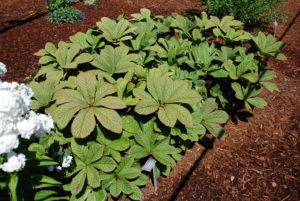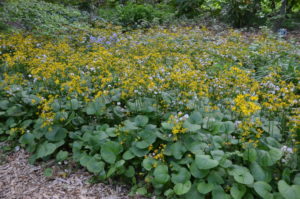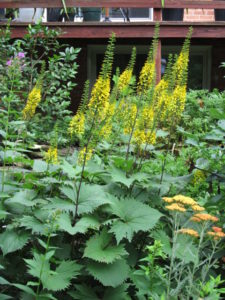Two outstanding summer flowering perennials are Rodgersia (two forms) and Ligularia. Both are grown for their broad foliage and showy flowers. They share one special need: consistent soil moisture through the spring and summer months. Don’t attempt to grow either one of these awesome plants unless their water needs will be satisfied. These plants prefer wet, boggy feet (roots).
Rodgersias (Rodgersia pinnata) sport bold pinnately compound leaves that emerge with a dark bronze tint. Leaves measure more than a foot wide and 3-4 foot high perennial. In early summer, white bloom panicles rise 2 to 3 feet above the foliage and bloom over 3 to 4 weeks. A secondary species, Chestnut-leaved Rodgersia (R. aesculifolia), is another clump form with bold green foliage and bears creamy-white flowers in mid-summer (USDA hardiness zones 5 to 8).
Varieties of rodgersia: ‘Chocolate Wing’ — cherry blossom pink and cream blooms); ‘Alba’- white flowers and dark green leaves/bronze veining.
Ligularias (ligs) are big leafy perennials whose roots must be kept constantly moist so that leaves don’t wilt or “faint”. Even after a summer shower, ligs may still go through a brief spell fainting in the mid-afternoon due to summer heat and water loss from transpiration. By early evening the leaves recover fully hydrated.
Bigleaf ligs (L. dentata) and narrow-spiked ligularias (L. stenocephala), aka “golden ray”, grow well in temperate climes (USDA hardiness zones 6 and 7). Tropical species are listed under the genus Farfugium (zones 7b -10).
Both ligularias (ligs) and rodgersia demand moist soils and in part day sun tor light shade. Site them nearby water features like within the splash-zone of a waterfall. They grow exceptionally well along woodland creeks.
When properly sited, the foliage remains blemish-free all season long. Disease and pest problems are rare if growing conditions are ideal. Deer and rabbits rarely trouble them.
Planting in containers: plant a single crown into a 3 to 5 gallon size container filled with humus-rich potting soil. To restrict most water loss, line the bottom of the container with plastic shopping bags. This reduces irrigation needs that saves on your monthly water bill.




 Posted in
Posted in 
